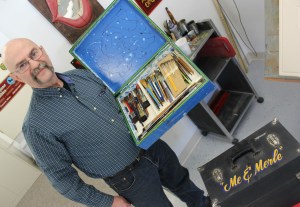PARIS — When Terry Swett was 16, he asked a renowned local sign maker, Merle Glines, for a job.
Glines said no.
Fast forward 40 years and the man who spent his life dedicated to making other businesses’ signs had spent the morning neatly stacking Heineken cases and uncorked wine bottles in a corner of his shop’s workspace. They were the remnants of an after-hours social gathering of business owners, the first held at his place and an indication that, in Western Maine, the site of his earliest setback, he’s made it.
“I became a sign painter in spite of not getting a job,” Swett said.
Swett, 58, owns and operates Swett Signs in the historic shell of the former Paris Fire Department station, a building restored and updated with modern touches.
But the latest turn in his life came a few months ago, when he acquired Glines’ original paintbrushes and sign-making lettering blocks from his widow. Now, the man who spent his life trying to prove he was worth being employed is painting with the equipment from the man who first rejected him.
“I might have turned out not to be such a punk kid as he probably thought I’d be,” Swett said.
Swett isn’t sure why he never got the job, but he didn’t let that deter him. After bouncing around different jobs, he started traveling the country, getting odd jobs painting signs or simply watching others at work.
His first job came when he was still living in Western Maine when he painted the local 4-H club’s bowling alley, then known as The Hole.
“I hungered to be wielding the brush,” he said.
Like everything else, sign-making has evolved over the decades to be dominated by computer design and digital printers. When he started though, logos were hand-drawn: An artist would tape a stencil to the object being painted and draw around it in chalk before painting it.
“We’ve got to get so much done in a shorter time these days,” Swett said. “That’s why everything’s evolved to be faster and more precise. But that sign up there was penciled and finished one stroke at a time,” he said, pointing to an original done by Glines.
Swett said getting his hands on Glines’ old paintbrushes has given him a new passion for hand-painting signs for the first time in years. It allows him as a craftsman to reconnect with the art, he said.
“It was like he was standing here with me. I hadn’t experienced that level of gratification in a long time,” he said.
Several original Glines’ signs hang above the worn casing containing the paint brushes like a shrine. Swett said he last talked to Merle six years ago at the Oxford County Fair in Oxford when he still operated a mobile sign-making business. Every few years, Glines would stop into the office, just to check up and see how he doing.
“I think it was meant to be for me to possess these things,” Swett said.

Comments are no longer available on this story